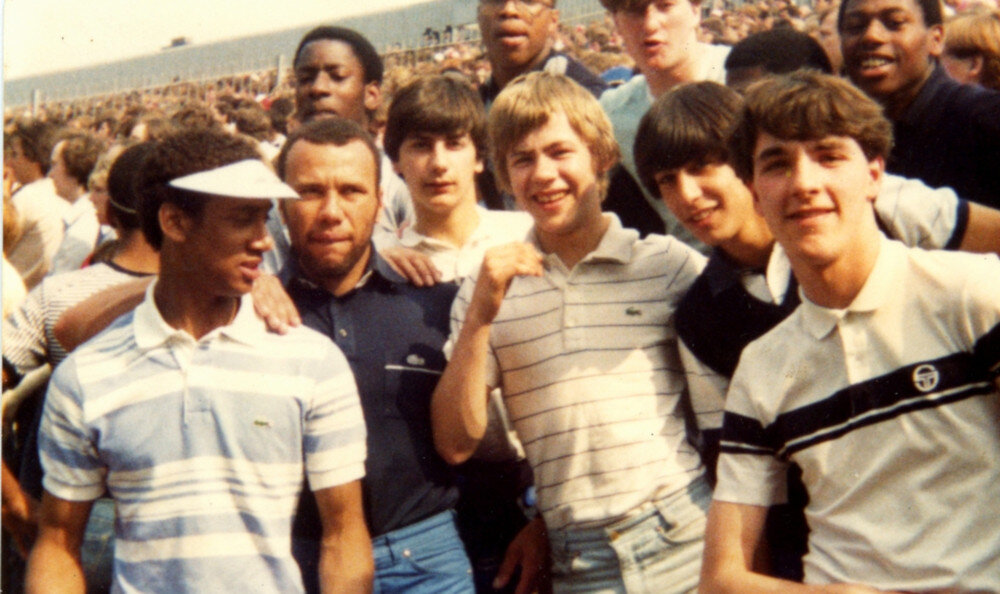From Sergio Tacchini to Stone Island | A Brief History of 'Casual' Fashion
A still from Kevin Sampson’s Away Days | Photo Credit
To understand the Casual subculture, one must have a knowledge of the various different subcultures which preceded it.
Between 1950 and the mid 1970’s, Britain experienced different youth movements such as the Teddy Boys, Rockers, the Skinheads, the Mods and the Punks. Whilst these subcultures differed greatly, they all shared one universal characteristic: Fashion and music were their driving force.
History of Casual Fashion
By the late 1970’s, Britain was ready for a new subculture to rise among the working class. Moreover, young football fans who would have considered themselves to be a little more discerning than the typical match goer, were searching for a way to make themselves stand out on the terrace.
By the end of the 1970s, British sides were starting to experience more consistent success in Europe. Glasgow Celtic and Manchester United won the European Cup in 1967 and 1968 respectively but it was the late-70s / early-80s when Britain truly became a dominant force on the European scene.
Between 1977 and 1984, 7 out of 8 European Cup winners hailed from England. The dominance of English sides in Europe meant that young fans were travelling regularly to exotic European destinations. Whilst on their travels, they came across rare brands heretofore not seen on the terraces of England. Gangs of fans would come back from the continent having stocked up on expensive clothing from brands such as Sergio Tacchini, Fila, Diadora, Lacoste and Pringle.
Lacoste and Sergio Tacchini were two of the most popular brands during the Casual era | Photo Credit
The clothing and the new look then became a source of pride for those who had been abroad following their football team. At a time when football hooliganism was on the rise, “looking the part” became another way for firms to get one over on your rivals. Being the most stylish firm in the country was almost as important as being the most feared firm around.
It’s important to note that this was a time long before the era of social media and online forums. The subculture had to spread organically. There were no lookbooks, no scheduled releases. Word of mouth was the prevalent source of information when it came to new clothing / shoe releases. You could turn up at the football on a Saturday and see a friend of yours wearing a pair of Adidas trainers you’d never seen before. A sense of one-upmanship quickly emerged, not only between rival firms but also within firms. The rarer the clothes/trainers, the better.
Whilst the continent was something of a holy grail for picking up new items, there were local innovators who contributed to the rise of the Casual. Wade Smith, a Liverpool-based sports shop owner used to travel across to Europe and bring back van loads of rare footwear. Whilst Wade Smith is likely the most well-known of the early ‘terrace fashion’ stores, there were several other entrepreneurs across England who catered for young casuals needs.
The Adidas Forest Hills were one of the rarest and most sought after pairs of trainers in the 70s/80s | Photo Credit
Music & Casual Culture
What unified the subculture was the desire and hunger for exclusive brands. It would be remiss however to assume that all firms adhered to the same dress code. Something of a ‘North-South divide’ definitely existed in this sense. Northern fans such as those of Liverpool and the Manchester clubs tended to opt for cagoules, skinny jeans and a pair of Adidas trainers. The tracksuits look was adopted mainly by the London clubs.
In the beginning of the article, we mentioned the importance of music to the subcultures which preceded the casuals. Whilst football and fashion were at the forefront of the Casual movement, music most definitely also played a role. Again, there was something of a ‘North-South divide’ when it came to the soundtrack of the terrace.
In terms of style, it was a very natural progression to go from being a Mod to becoming a Casual. Bands such as The Who, The Small Faces and The Kinks had all been popular amongst Mods. The popularity of reggae and soul music also highlighted a crossover in tastes between the Mods & the Skinheads. The Jam, fronted by Paul Weller, were heavily influenced by the Mod scene. Releasing their first album in 1977, it was no surprise that they would be popular amongst Casuals in England’s capital.
Another sound which was popular amongst the London Casuals, was Punk, to be more precise Oi Punk. One of the most prominent Oi Punk groups was the Cockney Rejects. At a time where football-related violence was at a high, the band's links with West Ham’s ‘Inter City Firm’ would often bring controversy upon them.
Up in Manchester and Liverpool, there was a plethora of talented bands coming through. On Merseyside, the ‘New Wave Scene’ was at its height with bands such as Echo & The Bunnymen, The Teardrop Explodes & Frankie Goes to Hollywood gaining popularity amongst Liverpool FC, Everton FC and Tranmere Rovers casuals. Meanwhile in Manchester, match-going folk were spoilt for choice in the late 1970s and early 1980s with bands such as Joy Division (later New Order) and The Smiths rising to fame.
Liverpool fans at Millwall in 1989. The jeans were becoming baggier and the outerwear looser. New trends were emerging | Photo Credit
By the end of the 1980s, change was on the horizon. The ‘Acid House’ scene was gaining popularity and pretty soon, the skinny jeans and smart cagoules would be swapped out for baggy jeans and loose t-shirts. There would be a return to the more traditional Casual look in the 90s but not without change. The brands seen on the terrace would become even more premium. Stone Island, Burberry, Prada and even Gucci became a common sight across England.
This new look would maintain its popularity moving into the new millennium. As social media and online forums started to pop up however, the movement became more accessible and less word-of-mouth. The subculture was also documented and reimagined in various different films and series. The exclusivity of the subculture was what made it so unique in the 1970s and 1980s and therefore, the movement started to die out somewhat by the noughties.
Films such a s Green Street put the subculture under the spotlight and some would argue that such films exaggerated and ultimately diluted the movement | Photo Credit
It is hard to imagine that a subculture such as this would be able to grow so organically today. Brands such as Stone Island, Adidas and so on continue to be popular amongst football fans today. What is different today perhaps is that these brands have become ubiquitous in all aspects of society. The Stone Island compass is no longer the badge of pride of the football casual.





